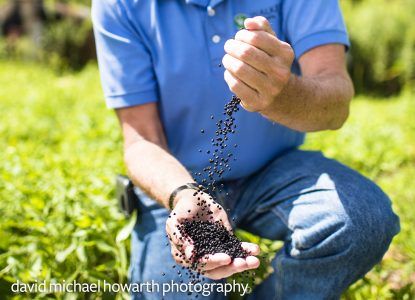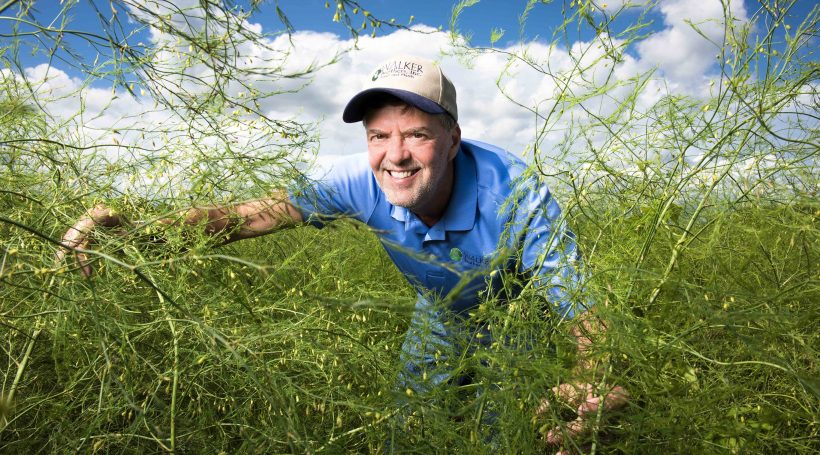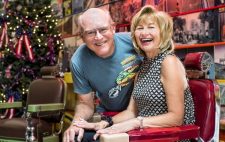 At Scott Walker’s farm in Pittsgrove, there are about 20 acres of feathery ferns growing under a giant mesh net. It’s possible you’ve never seen plants like these, with thin stalks that support berries which turn from green to deep red as they ripen. Honey bees bounce around between the rows, pollinating busily. The net above means those bees have the whole plot to themselves; bees from outside, carrying pollen from other plants, can’t get in.
At Scott Walker’s farm in Pittsgrove, there are about 20 acres of feathery ferns growing under a giant mesh net. It’s possible you’ve never seen plants like these, with thin stalks that support berries which turn from green to deep red as they ripen. Honey bees bounce around between the rows, pollinating busily. The net above means those bees have the whole plot to themselves; bees from outside, carrying pollen from other plants, can’t get in.
The berries each contain a handful of small seeds that will later be shipped all over the world – to Texas, Michigan, Guatemala, Peru, China, the list goes on. They’ll be used to grow a plant that looks a lot different from these ferns, and one you’d recognize right away: the thick, fibery stalks of asparagus.
Walker’s farm is pretty much the center of the world when it comes to asparagus production. He estimates that he’s responsible for between 30 and 40 percent of the world’s supply. And not because he’s growing the vegetable here in huge quantities (in fact, he really only grows enough to supply a small roadside stand), but because he’s the guy who grows the seeds.
“There are very few companies in the world breeding or producing asparagus seed,” explains Walker, 60. “The big companies don’t waste their time with seed production.”
It’s a time-consuming process. Asparagus plants don’t mature for several years after they’re planted, and once the plant goes to seed – the ferns shoot out from the tip of the asparagus spear – the plant itself becomes inedible. Letting plants go to seed cuts into production, so it’s in a produce company’s best interest to harvest the spears long before that point. Even if a major producer did want to harvest their own seeds, getting the berries off the ferns and separating out the seeds is no small feat.
“You go out into the field and cut the ferns by hand,” Walker says. “Then you let them dry for a day or two. The ferns are fed into a stationary combine that shakes out the berries. Then they’re put into a machine we call a mascerator. It has steel blades that cut up the berries and send it out all onto a conveyor where we wash out the pulp. Then you flood the seeds with water; good seed will sink and bad seed floats. You try to float off everything on top, then you gather the heavy seed into a machine that’s like a big hairdryer. It blows out the seeds that are lighter, because they might not be as healthy. What you’re left with is the heavy, high-quality, live seeds.”
And even though asparagus is one of the only perennial vegetables, and a single plant can continue producing for decades, worldwide demand means new seeds are being germinated all the time.
“We sell anywhere between 8,000 and 10,000 pounds of seed a year,” Walker says. Most of that is produced at another, larger facility in California that Walker also owns, but the really important work – the science that’s keeping asparagus in grocery stores and on your plate – is happening right here in South Jersey. The 20 netted acres of plants here are the foundation of a breeding program. Walker carefully cross-breeds plants to produce new varieties with genetic properties that help them grow in different climates around the world.
“We have varieties that do better in arid climates and varieties that do better in cooler climates,” Walker says.
“We’re seeing increases in temperatures around the world, and heat makes the head of the asparagus spear open up. Once the head opens, that’s not a marketable spear. So we work on creating varieties that will tolerate the changing climate. I was just out in California, and it was 116 degrees. We’re looking for plants that can take the heat, because that’s the future. The varieties that are working today probably won’t work in five years, so we have to be ready with something new.”
Today, most of the world’s asparagus production happens outside the United States.
“In the early ’90s, the United States had about 110,000 acres of asparagus,” Walker says.
“Today, we have maybe 30,000. Asparagus growing and harvesting is labor-intensive, and most of it has moved to Mexico and Peru. But that’s changing too, and now Peru is getting into different crops and China is ramping up asparagus production.”
Despite the fact that very little asparagus is now grown in New Jersey – Walker estimates there’s only about 2,000 acres of it in the state today – the veggie has a long history in the Garden State.
“Once upon a time, Jersey was the second-largest producer in the United States,” he says.
“We had about 35,000 acres in the ’60s or ’70s. That was before the invention of hybrid varieties – it was all an old breed called Mary Washington. It was a really poor-yielding, non-disease-tolerant variety, but for a while it was really thriving in Jersey. Then, there was a stretch of summers with lots of rainfall, and growers were overharvesting, which stresses and weakens the crops. Because of the rain and the overharvesting, a disease called Fusarium showed up in the soil. That was the beginning of the end.”
Now, the Fusarium-infected soil and South Jersey’s climate make it the perfect place for Walker to develop and test varieties that can thrive around the world.
“If it can survive South Jersey – the heat and humidity, the cold snaps, the rainfall and the Fusarium,” Walker says, “it will grow anywhere.”
Walker is a fifth-generation farmer – his family has owned the acreage in Pittsgrove since the mid 1800s – but it was his father and uncle who first focused on asparagus. The seed production program began in earnest in 1987 through a partnership with Rutgers University, and today Walker Seed is the world’s largest producer of hybrid asparagus seed. Their Atlas F1 variety thrives in the sandy soil on the coast of Peru, and Grande F1 has shown promise in Changxing, China.
A variety Walker developed himself – dubbed Walker Deluxe F1 – is now being grown in the United States and, for Walker, it’s the culmination of more than a decade of work.
“When you try to develop a variety, you go out in the field and find plants that have naturally survived disease and stress over the years,” he says.
“You bring them back to the farm and [cross-pollinate] them, then harvest the seed and plant that. You harvest the spears over the next six years and evaluate them. When you find two parent plants that create a favorable offspring, you have to clone them. You need thousands of those plants, and that takes about a year. If everything clicks, it’s 10 or 15 years before you have seeds to sell.”
Walker says he doesn’t always try to explain exactly what he does for a living, because people tend not to understand it. He usually just calls himself an asparagus farmer.
“But I guess there aren’t many farmers who are constantly flying to places all around the world to evaluate fields,” he laughs.
“Plus, every four years there’s an international asparagus symposium. In 2017 we were in Germany, and in 2021 we’ll be in Spain. We’ve had them in New Zealand, China, Japan, Netherlands – we really get around.”














